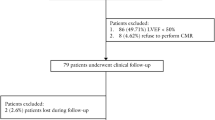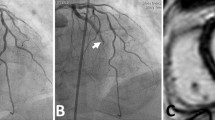Abstract
The aim of this study was to compare the prognostic significance of microvascular obstruction (MO) and persistent microvascular obstruction (PMO) as assessed by cardiac magnetic resonance (CMR) in patients with acute myocardial infarction (AMI). CMR was performed in 184 patients within the week following successfully reperfused first AMI. First-pass images were performed to evaluate extent of MO and late gadolinium-enhanced images to assess PMO and infarct size (IS). Major adverse cardiac events (MACE) were collected at 1-year follow-up. MO and PMO were found in 127 (69%) and 87 (47%) patients, respectively. By using univariate logistic regression analysis, high Global Registry of Acute Coronary Events (GRACE) risk score (odds ratio [OR] 95% confidence interval [CI]: 3.6 [1.8–7.4], p < 0.001), IS greater than 10% (OR [95% CI]: 2.7 [1.1–6.9], p = 0.036), left ventricular ejection fraction less than 40% (OR [95% CI]: 2.4 [1.1–5.2], p = 0.027), presence of MO (OR [95% CI]: 3.1 [1.3–7.3], p = 0.004) and presence of PMO (OR [95% CI]:10 [4.1–23.9], p < 0.001) were shown to be significantly associated with the outcome. By using multivariate analysis, presence of MO (OR [95% CI]: 2.5 [1.0–6.2], p = 0.045) or of PMO (OR [95% CI]: 8.7 [3.6–21.1], p < 0.001), associated with GRACE score, were predictors of MACE. Presence of microvascular obstruction and persistent microvascular obstruction is very common in AMI patients even after successful reperfusion and is associated with a dramatically higher risk of subsequent cardiovascular events, beyond established prognostic markers. Moreover, our data suggest that the prognostic impact of PMO might be superior to MO.



Similar content being viewed by others
References
Kloner RA, Ganote CE, Jennings RB (1974) The “no-reflow” phenomenon after temporary coronary occlusion in the dog. J Clin Invest 54:1496–1508
Wu KC, Zerhouni EA, Judd RM, Lugo-Olivieri CH, Barouch LA, Schulman SP, Blumenthal RS, Lima JA (1998) Prognostic significance of microvascular obstruction by magnetic resonance imaging in patients with acute myocardial infarction. Circulation 97:765–772
Rogers WJ, Kramer CM, Geskin G, Hu YL, Theobald TM, Vido DA, Petruolo S, Reichek N (1999) Early contrast-enhanced MRI predicts late functional recovery after reperfused myocardial infarction. Circulation 99:744–750
Judd RM, Lugo-Olivieri CH, Arai M, Kondo T, Croisille P, Lima JA, Mohan V, Becker LC, Zerhouni EA (1995) Physiological basis of myocardial contrast enhancement in fast magnetic resonance images of 2-day-old reperfused canine infarcts. Circulation 92:1902–1910
Rochitte CE, Lima JA, Bluemke DA, Reeder SB, McVeigh ER, Furuta T, Becker LC, Melin JA (1998) Magnitude and time course of microvascular obstruction and tissue injury after acute myocardial infarction. Circulation 98:1006–1014
Hombach V, Grebe O, Merkle N, Waldenmaier S, Höher M, Kochs M, Wöhrle J, Kestler HA (2005) Sequelae of acute myocardial infarction regarding cardiac structure and function and their prognostic significance as assessed by magnetic resonance imaging. Eur Heart J 26:549–557
Alpert JS, Thygesen K, Antman E, Bassand JP (2000) Myocardial infarction redefined—a consensus document of The European Society of Cardiology/American Society of Cardiology Committee for the Redefiniton of Myocardial Infarction. J Am Coll Cardiol 36:959–969
Cockcroft DW, Gault MH (1976) Prediction of creatinine clearance from serum creatinine. Nephron 16:31–41
Fox KA, Dabbous OH, Goldberg RJ, Pieper KS, Eagle KA, Van de Werf F, Avezum A, Goodman SG, Flather MD, Anderson FA, Granger CB (2006) Prediction of risk of death and myocardial infarction in the six months after presentation with acute coronary syndrome: prospective multinational observational study (GRACE). BMJ 333:1091–1094
Cottin Y, Touzery C, Guy F, Lalande A, Ressencourt O, Roy S, Walker PM, Louis P, Brunotte F, Wolf JE (1999) MR imaging of the heart after myocardial infarction: effect of increasing intersection gap on measurement of left ventricular volume, ejection fraction, and wall-thickness. Radiology 213:513–520
Foo TKF, Bernstein MA, Aisen AM, Hernandez RJ, Collick BD, Bernstein T (1995) Improved ejection fraction and flow velocity estimates with use of view-sharing and uniform repetition time excitation with fast cardiac techniques. Radiology 195:471–478
Simonetti O, Kim RJ, Fieno DS, Hillenbrand HB, Wu E, Bundy JM, Finn JP, Judd RM (2001) An improved MR Imaging technique for the visualisation of myocardial infarction. Radiology 218:215–223
Beek AM, Kuhl HP, Bondarenko O, Twisk JW, Hofman MB, van Dockum WG, Visser CA, van Rossum AC (2003) Delayed contrast-enhanced magnetic resonance imaging for the prediction of regional functional improvement after acute myocardial infarction. J Am Coll Cardiol 42:895–901
Mollet NR, Dymarkowski S, Volders W, Wathiong J, Herbots L, Rademakers FE, Bogaert J (2002) Visualization of ventricular thrombi with contrast-enhanced magnetic resonance imaging in patients with ischemic heart disease. Circulation 106:2873–2876
Cerqueira MD, Weissman NJ, Dilsizian V, Jacobs AK, Kaul S, Laskey WK, Pennell DJ, Rumberger JA, Ryan T, Verani MS, American Heart Association Writing Group on Myocardial Segmentation and Registration for Cardiac Imaging (2002) Standardized myocardial segmentation and nomenclature for tomographic imaging of the heart. Circulation 105:539–542
Choi KM, Kim RJ, Gubernikoff G, Vargas JD, Parker M, Judd RM (2001) Transmural extent of acute myocardial infarction predicts long-term improvement in contractile function. Circulation 104:1101–1107
Engler RL, Schmid-Schonbein GW, Pavelec RS (1983) Leukocyte capillary plugging in myocardial ischemia and reperfusion in dogs. Am J Pathol 111:98–111
Topol EJ, Yadav JS (2000) Recognition of the importance of embolization in atherosclerotic vascular disease. Circulation 101:570–580
Wu KC, Kim RJ, Bluemke DA, Rochitte CE, Zerhouni EA, Becker LC, Lima JA (1998) Quantification and time course of microvascular obstruction by contrast-enhanced echocardiography and magnetic resonance imaging following acute myocardial infarction and reperfusion. J Am Coll Cardiol 32:1756–1764
Lund GK, Stork A, Saeed M, Bansmann MP, Gerken JH, Muller V, Mester J, Higgins CB, Adam G, Meinertz T (2004) Acute myocardial infarction: evaluation with first-pass enhancement and delayed enhancement MR imaging compared with 201Tl SPECT imaging. Radiology 232:49–57
Lima JAC, Judd RM, Bazille A, Schulman SP, Atalar E, Zerhouni EA (1995) Regional heterogeneity of human myocardial infarcts demonstrated by contrast-enhanced MRI. Potential mechanisms. Circulation 92:1117–1125
Comte A, Kastler B, Laborie L, Hadjidekov G, Meneveau N, Boulahdour H (2008) Using a contrast-enhanced imaging sequence at 3 minute delay in 3T magnetic resonance imaging for acute infarct evaluation. Invest Radiol 43:669–675
Villanueva FS (2002) Myocardial contrast echo in acute myocardial infarction. Am J Cardiol 90:suppl:38j–47j
Iwakura K, Ito H, Kawano S, Shintani Y, Yamamoto K, Kato A, Ikushima M, Tanaka K, Kitakaze M, Hori M, Higashino Y, Fujii K (2001) Predictive factors for development of the no-reflow phenomenon in patients with reperfused anterior wall acute myocardial infarction. J Am Coll Cardiol 38:472–477
Ito H, Maruyama A, Iwakura K, Takiuchi S, Masuyama T, Hori M, Higashino Y, Fujii K, Minamino T (1996) Clinical implications of the “no reflow” phenomenon. A predictor of complications and left ventricular remodelling in reperfused anterior wall myocardial infarction. Circulation 93:223–228
Morishima I, Sone T, Okumura K, Tsuboi H, Kondo J, Mukawa H, Matsui H, Toki Y, Ito T, Hayakama T (2000) Angiographic no-reflow phenomenon as a predictor of adverse long-term outcome in patients treated with percutaneous transluminal coronary angioplasty for first acute myocardial infarction. J Am Coll Cardiol 36:1202–1209
Gibson CM, Cannon CP, Murphy SA, Ryan KA, Mesley R, Marble SJ, McCabe CH, Van de Werf F, Braunwald E (2000) Relationship of TIMI myocardial perfusion grade to mortality after administration of thrombolytic drugs. Circulation 101:125–130
Gerber BL, Rochitte CE, Melin JA, McVeigh ER, Bluemke DA, Wu KC, Becker LC, Lima JA (2000) Microvascular obstruction and left ventricular remodelling early after acute myocardial infarction. Circulation 101:2734–2741
Galiuto L, Garramone B, Scara A, Rebuzzi AG, Crea F, La Torre G, Funaro S, Madonna M, Fedele F, Agati L (2008) The extent of microvascular damage during myocardial contrast echocardiography is superior to other known indexes of post-infarct reperfusion in predicting left ventricular remodeling. Results of the multicenter AMICI Study. J Am Coll Cardiol 51:552–559
Tanaka A, Kawarabayashi T, Nishibori Y, Sano T, Nishida Y, Fukuda D, Shimada K, Yoshikawa J (2002) No-reflow phenomenon and lesion morphology in patients with acute myocardial infarction. Circulation 105:2148–2152
Hoffmann R, Mintz GS, Mehran R, Pichard AD, Kent KM, Satler LF, Popma JJ, Hongsheng W, Leon MB (1998) Intravascular ultrasound predictors of angiographic restenosis in lesions treated with Palmar-Schatz stents. J Am Coll Cardiol 31:43–49
Schwitter J, Wacker CM, van Rossum AC, Lombardi M, Al-Saadi N, Ahlstrom H, Dill T, Larsson HBW, Flamm SD, Marquadt M, Johansson L (2008) MR-IMPACT: comparison of perfusion-cardiac magnetic resonance with single-photon emission computed tomography for the detection of coronary artery disease in a multicentre, multivendor, randomized trial. Eur Heart J 29:480–489
Acknowledgements
This work was supported by the Association de Cardiologie de Bourgogne and by grants from the University Hospital of Dijon, France. The authors are grateful for P. Bastable for his help in the preparation of the manuscript, and Dr C. Boichot for the collection of data.
Author information
Authors and Affiliations
Corresponding author
Rights and permissions
About this article
Cite this article
Cochet, A.A., Lorgis, L., Lalande, A. et al. Major prognostic impact of persistent microvascular obstruction as assessed by contrast-enhanced cardiac magnetic resonance in reperfused acute myocardial infarction. Eur Radiol 19, 2117–2126 (2009). https://doi.org/10.1007/s00330-009-1395-5
Received:
Revised:
Accepted:
Published:
Issue Date:
DOI: https://doi.org/10.1007/s00330-009-1395-5




